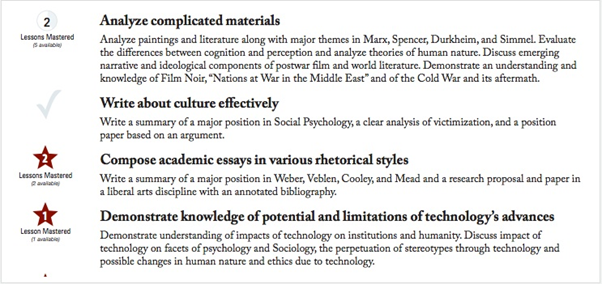27. Competency-Based Learning
27.3. Designing Competency-Based Learning
There are various approaches, but the Western Governors’ model illustrates many of the key steps.
Defining CompetenciesA feature of most competency-based programs is a partnership between employers and educators in identifying the competencies required, at least at a high level. Some of the skills outlined such as problem-solving or critical thinking, maybe considered high-level, but competency-based learning tries to break down abstract or vague goals into specific, measurable competencies.
For instance, at Western Governors University (WGU), for each degree, a high-level set of competencies is defined by the University Council, and then a working team of contracted subject matter experts take the ten or so high-level competencies for a particular qualification and breaks them down into about 30 more specific competencies, around which are built online courses to develop mastery of each competency. Competencies are based upon what graduates are supposed to know in the workplace and as professionals in a chosen career. Assessments are designed specifically to assess the mastery of each competency; thus students receive either a pass/no pass following assessment. A degree is awarded when all 30 specified competencies are successfully achieved.
Defining competencies that meet the needs of students and employers in ways that are progressive (in that one competency builds on earlier competencies and leads to more advanced competencies) and coherent (in that the sum of all the competencies produces a graduate with all the knowledge and skills required within a business or profession) is perhaps the most important and most difficult part of competency-based learning.
Course and Program DesignAt WGU, courses are created by in-house subject matter experts selecting existing online curriculum from third parties and/or resources such as e-textbooks through contracts with publishers. Increasingly open educational resources are used. WGU does not use a learning management system but a specially designed portal for each course. E-textbooks are offered to students without extra cost to the student, through contracts between WGU and the publishers. Courses are pre-determined for the student with no electives. Students are admitted on a monthly basis and work their way through each competency at their own pace.
Students who already possess competencies may accelerate through their program in two ways: transferring in credits from a previous associate degree in appropriate areas (e.g. general education, writing); or by taking exams when they feel they are ready (sometimes known as direct assessment).
Learner SupportAgain this varies from institution to institution. WGU currently employs approximately 750 faculty who act as mentors. There are two kinds of mentors: ‘student’ mentors and ‘course’ mentors. Student mentors, who have qualifications within the subject domain, usually at a masters level, are in at least bi-weekly telephone contact with their students, depending on the needs of the student in working through their courses, and are the main contact for students. A student mentor is responsible for roughly 85 students. Students start with a mentor from their first day and stay with their mentor until graduation. Student mentors assist students in determining and maintaining an appropriate pace of study and step in with help when students are struggling.
Course mentors are more highly qualified, usually with a doctorate, and provide extra support for students when needed. Course mentors will be available to between 200-400 students at a time, depending on the subject requirement.
Students may contact either student or course mentors at any time (unlimited access) and mentors are expected to deal with student calls within one business day. Mentors are full-time but work flexible hours, usually from home. Mentors are reasonably well paid and receive extensive training in mentoring.
AssessmentWGU uses written papers, portfolios, projects, observed student performance, and computer-marked assignments as appropriate, with detailed rubrics. Assessments are submitted online and if they require human evaluation, qualified graders (subject matter experts trained by WGU in assessment) are randomly assigned to mark work on a pass/fail basis. If students fail, the graders provide feedback on the areas where competency was not demonstrated. Students may resubmit if necessary.

Students will take both formative (pre-assessment) and summative (proctored) exams. WGU is increasingly using online proctoring, enabling students to take an exam at home under video supervision, using facial recognition technology to ensure that the registered student is taking the exam. In areas such as teaching and health, student performance or practice is assessed in situ by professionals (teachers, nurses).

Direct assessment, meaning students taking an exam when they feel ready, is, of course, de-coupled from the standard credit hour, since different students may take different times to reach proficiency. In the USA, where financial aid is generally linked to the number of credit hours in a course or program, this can cause problems with regulatory agencies. Although regulators are grappling with this issue, the uncertainty around financial aid is a major reason for the relatively low use of direct assessment in competency-based learning, despite it being one of its main advantages (see Fain, 2019, for more on this issue).
